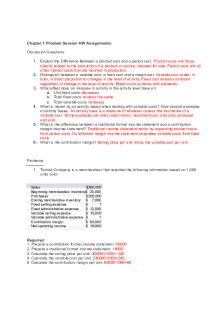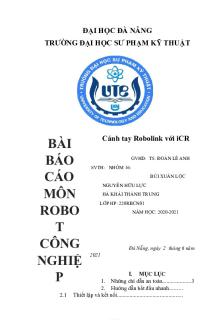HLSC 220 Notes-127-132 PDF

| Title | HLSC 220 Notes-127-132 |
|---|---|
| Author | Victoria Hagel |
| Course | Pharmacotherapeutics for Health Professionals |
| Institution | MacEwan University |
| Pages | 6 |
| File Size | 217.9 KB |
| File Type | |
| Total Downloads | 27 |
| Total Views | 170 |
Summary
HLSC 220 Notes-127-132...
Description
HLSC 220
Antidysrhythmic Drugs A Beating Heart Rate: frequency/unit time o 70 beats/min Rhythm: the regularity or irregularity of the beating Electrical activity spreads throughout heart tissue in a co-ordinated manner o ion channels in cell membrane Electrical activity leads to mechanical activity o co-ordinated contraction of cardiac muscle
• • • •
Definition Dysrhythmia o Any deviation from the normal rate/rhythm of the heart Arrhythmia “no rhythm” o Asystole – no heartbeat
• •
Dysrhythmias Tachydysrhythmias o HR is increased o MUCH more common o Drugs and other treatments Brady dysrhythmias o HR is slowed o Electrical pacing o Atropine
•
•
•
•
Many causes of dysrhythmias o ischemic heart disease o myocardial infarction o cardiomyopathy o myocarditis o electrolyte imbalances (eg abnormal K+ level) Antidysrhythmics (antiarhythmics) o drugs used for the treatment and prevention of disturbances in cardiac rate and/or rhythm o most suppress abnormal electrical impulse formation or conduction
Cardiac Electrical Activity • • • • •
SA node cells AV node cells Purkinje cells Ventricular cells Electrical activity
127
HLSC 220 •
differs with each cell type
AP and Cardiac Muscle Contraction • •
Movement of ions across the cardiac cell membrane results in AP generation AP leads to contraction of the myocardial muscle
Cardiac Electrical Activity •
Cardiac physiology o Action potentials differ between cardiac cell types
SA and AV Node Cells • •
AP depends on Ca2+ influx via Ca channels
Ventricular/Atrial Cardiac Muscle Cell • •
AP starts with Na+ influx = depolarization o via Na channels AP ends with K+ efflux = repolarization o via K channels
Cardiac Electrical Activity
128
HLSC 220
Dysrhythmias •
• • •
• • • • • • •
Symptoms o palpitations o dizziness o fainting o dypsnea Some are asymptomatic Supraventricular tachycardia (SVT 120-250 beats/min) o Where is the problem? Supraventricular tachycardia o Paroxysmal § episodic, start suddenly and returns to normal (within ~24 hours) o Persistent § episodes longer than seven days § usually treatment is needed to return the heart to a normal rhythm o Permanent § dysrhythmia lasts for more than a year despite medications and other treatments Supraventricular tachycardia o Atrial flutter Supraventricular tachycardia o Atrial fibrillation § most common Ventricular Tachycardia (VT) Problem with ventricular muscle o eg non-sustained (30 sec) Ventricular fibrillation o Why is this bad? Supraventricular dysrhythmias affect ventricular contraction rate o A-V block desirable Ventricular dysrhythmias more dangerous than supraventicular
Antidysrhythmic Drugs : Mechanism of Action •
Large variety of drugs o Categorized according to how drugs alter heart function o Vaughan Williams Classification
Antidysrhythmic Drugs 129
HLSC 220 •
ALL antidysrhythmics can cause dysrhythmias! o Create new and/or worsen existing ones
Antidysrhythmic Drugs - Vaughan Williams Classification •
• • • •
Class I – Na channel blockers o Class Ia o Class Ib o Class Ic Class II – b blockers Class III – K channel blockers (+ others) Class IV - Calcium channel blockers Other (adenosine, digoxin)
Class I: Na Channel Blockers
• •
• • • • •
• • • •
•
AP starts with Na+ influx = depolarization all block Na channels o slow depolarization o Subdivided due to differing pharmacological effects Class Ia : quinidine , procainamide, disopyramide o Block sodium channels Slows atrial and ventricular rates Also delay repolarization (Class III action) Increase the APD Used for ACU ACUTE TE onset atrial fibrillation o premature atrial contractions (PAC) o premature ventricular contractions (PVCs) o ventricular tachycardia o Wolff-Parkinson-White syndrome (usually tachy, may cause atrial fib/flutter) Class Ib : lidocaine (IV) o Block sodium channels Accelerate repolarization Decrease the APD Used for ventricular dysrhyt dysrhythmias hmias only o premature ventricular contractions (PVC) o ventricular tachycardia o fibrillation after MI Class Ic: flecainide, encainide, propafenone o Block sodium channels
130
HLSC 220 • •
Little effect on APD or repolarization Used for: o severe ventricular dysrhythmias o atrial fibrillation
Class II: b-adrenoceptor Antagonists • • • • • •
In SA & AV AP depends on Ca2+ influx B-adrenergic receptors increase Ca influx therefore B-blockers reduce cell activity Class II : b-adrenoceptor antagonists (beta blockers) Metoprololl, esmolol (IV), propranolol, sotalol (also Class III) o Metoprolo Reduce or block sympathetic nervous system stimulation o AV Block General myocardial depressants for both supraventricular and ventricular dysrhythmias
Class III: Potassium Channel Blockers • • •
• •
AP ends with K+ efflux = repolarization o Potassium channels blockers prolong AP Class III : amiodarone, dofetilide, sotalol, bretylium Prolong repolarization o prolong cardiac AP § extends refractory period of cells Amiodarone also affects SA node, contractility Amiodarone – very effective drug o but ~ 75% have serious AE if used for 6 months eg lung fibrosis, thyroid o 10% are fatal o Used for o Ventricular tachycardia or fibrillation, atrial fibrillation or flutter § resistant to other drugs o Sustained ventricular tachycardia
Class IV: Calcium Channel Blockers • • • • • • •
In SA & AV AP depends on Ca2+ influx Ca channel blockers reduce cell electrical activity Class IV : diltiazem , verapamil Calcium channel blockers - CCBs o Inhibits Ca cell entry o “Cardio-active” Act on AV node – reduce conduction velocity o AV Block Used for paroxysmal (“periodic attack”) SVT o Rate control for atrial fibrillation and flutter Not for ventricular dysrhythmias
Unclassified Antidysrhythmics •
Digoxin and adenosine
131
HLSC 220
•
•
o Do not fit into Classes I – IV o Both decease AV conduction and SA automaticity Digoxin o AV block o Slows HR o See ionotropics class for other actions of digoxin Adenosine o Slows conduction through the AV node § AV block o Used to convert paroxysmal supraventricular tachycardia to sinus rhythm o Short half-life — 10 to 20 sec o Only administered as fast IV push o May cause asystole for a few seconds
Antidysrhythmic Drugs: Adverse Effects l ALL antidysrhythmics can cause dysrhythmias!
Nursing Implications •
• • •
Ensure that the client knows to notify health care provider of any worsening of dysrhythmia and: o Shortness of breath o Edema o Dizziness o Syncope o Possible signs of toxicity of the drug Clients taking B-Blockers or digoxin, and other agents should be taught how to take their own radial pulse for 1 full minute notify their physician if the pulse is less than 60 beats/minute before taking the next dose of medication Monitor for therapeutic response o Decreased BP in hypertensive clients o Decreased edema o Regular pulse rate o Pulse rate without major irregularities o Improved cardiac output
132...
Similar Free PDFs

HLSC 220 formative quiz
- 14 Pages

HLSC 220 Notes-127-132
- 6 Pages

HLSC 3510OL Spring 2020
- 5 Pages

Reference list HLSC 122
- 1 Pages

Outline HLSC 2P49
- 11 Pages

SLK 220 - Chapter 11
- 9 Pages

Chapter 1 Accounting 220
- 3 Pages

Baocao RBCN 220 LLT
- 86 Pages

CS211 611 lecture 220
- 23 Pages

GProject STA 220
- 24 Pages

Resumen NIA 220
- 3 Pages

Restoration Pamphlet BIO 220
- 3 Pages

Milestone One HSE 220
- 1 Pages

Psych 220 Personality Syllabus
- 8 Pages
Popular Institutions
- Tinajero National High School - Annex
- Politeknik Caltex Riau
- Yokohama City University
- SGT University
- University of Al-Qadisiyah
- Divine Word College of Vigan
- Techniek College Rotterdam
- Universidade de Santiago
- Universiti Teknologi MARA Cawangan Johor Kampus Pasir Gudang
- Poltekkes Kemenkes Yogyakarta
- Baguio City National High School
- Colegio san marcos
- preparatoria uno
- Centro de Bachillerato Tecnológico Industrial y de Servicios No. 107
- Dalian Maritime University
- Quang Trung Secondary School
- Colegio Tecnológico en Informática
- Corporación Regional de Educación Superior
- Grupo CEDVA
- Dar Al Uloom University
- Centro de Estudios Preuniversitarios de la Universidad Nacional de Ingeniería
- 上智大学
- Aakash International School, Nuna Majara
- San Felipe Neri Catholic School
- Kang Chiao International School - New Taipei City
- Misamis Occidental National High School
- Institución Educativa Escuela Normal Juan Ladrilleros
- Kolehiyo ng Pantukan
- Batanes State College
- Instituto Continental
- Sekolah Menengah Kejuruan Kesehatan Kaltara (Tarakan)
- Colegio de La Inmaculada Concepcion - Cebu

